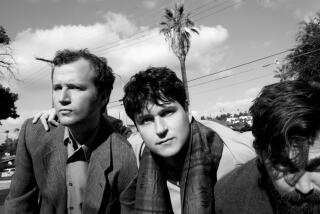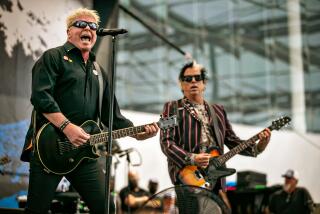Slayer, ‘the hardest band in history,’ throws devil horns for final time at Forum this weekend
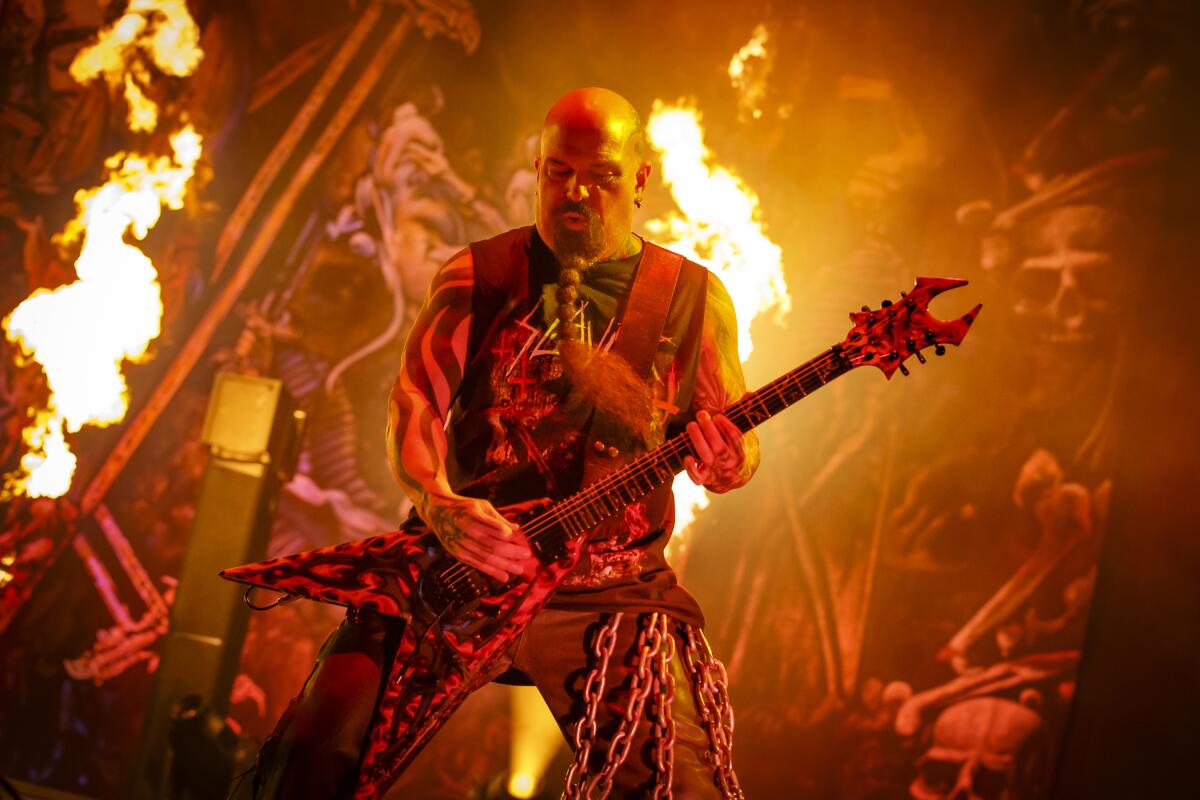
In the early days of thrash, not every town was ready for the arrival of Slayer. The band’s longtime manager, Rick Sales, remembers hearing of a document shared among police departments in the 1980s that warned of Slayer’s extreme metal sound and the equally extreme intensity of fans.
“It was more like a guide to watch out: ‘This is what happens at a Slayer show. It is dangerous,’” Sales, 66, says of the heavy metal intel traded across the country. “The audience, the mosh pits and the energy level was something that no one had seen.”
Decades later, tour stops around the world are mostly at peace with Slayer’s music of speed and terror, melding the sound of British heavy metal with hardcore punk. And yet as the band heads towards retirement from live performing after 38 years — with final concerts Friday and Saturday at the Forum — Slayer’s influence on the metal masses has not faded.
Then as now, the Southern California thrashers deliver a reliably dark and aggressive message, as pure in their chosen genre as the Ramones were in the first wave of punk. Fans still greet each other at concerts with an agonized, one-word battle cry to signify devotion and awe: “Slayer!”
“Slayer is the hardest band in history,” says Rick Rubin, who produced the act’s career-defining album, 1986’s “Reign in Blood,” after signing the group to his Def Jam label. (Slayer later followed Rubin to Def American and American Recordings.) “They seemed to play guitars in a different way than the instruments were intended. Almost as if animals found relics of guitars with no knowledge of how they had been developed. The guitar solos were abstract energy bursts of ‘nonmusic.’ Everything was based on energy.”
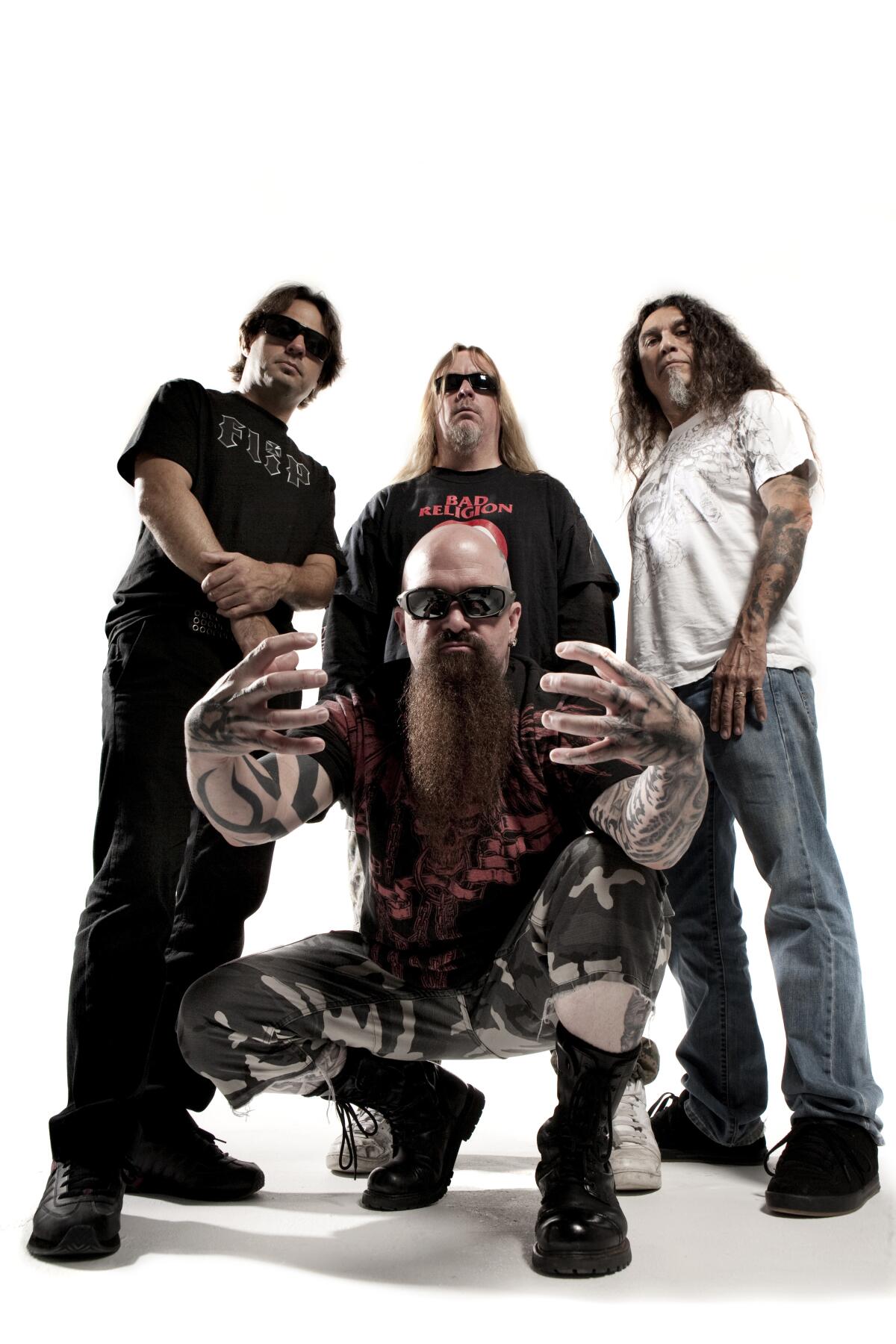
The music of thrash is insanely fast, with a panicked machine-gun beat and a hornet’s nest of guitars, sped up from the examples of Eddie Van Halen and Randy Rhoads into something quicker, harsher. (And no ballads. Ever.) A full generation younger than metal originators Black Sabbath or Judas Priest, Slayer could have continued onward for another decade or more, presiding over mosh pits internationally with speedy guitars, pentagrams and bleak horror fantasies.
Aside from songs of pure madness and mutilation, Slayer explored real-world themes through the anti-religious screeds “Jesus Saves” and “Jihad” and several blood-soaked antiwar tracks. Especially controversial was “Angel of Death,” about ghoulish Nazi physician Josef Mengele, a song Def Jam partner Columbia Records refused to release as part of “Reign”; the album ultimately came out on Geffen.
Beginning with “Reign,” Slayer earned four gold albums in the U.S., but if it never reached the platinum status of certain metal contemporaries, no band was more influential on future players of heavy music. Slayer’s impact can be heard in acts like Lamb of God, Marilyn Manson and System of a Down, and within the riffs of some of the youngest generation of metal, including Code Orange; the band still reliably attracts new waves of young true believers in black T-shirts and tattoos.
The tour ending this weekend after nearly 150 dates since May 10, 2018, is called the Final Campaign, and has passed through 40 countries, says Sales. At the Forum, Slayer will be supported by an all-star lineup of heavy-hitters: Primus, Ministry and Philip H. Anselmo and the Illegals (performing a set of Pantera songs).
At stage left will be Kerry King, 55, with shaved head and braided beard, head-banging aggressively over his guitar, the words GOD HATES US ALL tattooed in block letters along his left arm. Behind the microphone will be Tom Araya, 58, in long black hair and gray whiskers, snarling and grinning impishly over the swirling circle pit in front of him.
While Slayer’s band members are not doing any interviews in connection with this final tour, some of the quartet’s longtime friends and collaborators recalled the impact of what Rubin describes as the band’s “all-out attack” and the most “dedicated, extreme following of any artist in any genre.”

The decision to end the band’s career as an active performing and recording unit came as a surprise to Sales, who had been discussing future projects with founding singer-bassist Araya and guitarist King. After more than three decades together, Slayer decided to launch a farewell tour in early 2018.
“They’ve been doing this for so long. They just said, ‘OK, this is enough,’” says Sales. “My analogy is Jerry Seinfeld, who had probably the biggest TV show when he went out on top. I respect the band for the decision. If you’re going to do it, this is the way.”
Just hours before he spoke, Mötley Crüe had released a video announcing another return to action, after promising its last tour was the end, even signing a legal contract. Sales doesn’t foresee Slayer changing its mind.
“I’m not sensing that at all,” he says. “Let’s put the touring to bed. I’ve got a couple of ideas [for future projects], but we haven’t made any decisions. Right now, they’re preoccupied with the end, and I imagine it’s emotional. It’s emotional for me.”
In 1986, Sales was recruited by Rubin as Slayer’s new road manager, and he was the first to put the band on a tour bus. Before that, Slayer had done much of its touring from Araya’s Camaro and a U-Haul trailer. Before Slayer, Sales had road-managed for Blue Öyster Cult and Herbie Hancock. This was different.
Fans were explosive, raising devil’s horns into the air and leaping from balconies, and the songs were loud and crazed, about serial killers, war criminals and madman Ed Gein.
“Once, Tom had a death threat, and I remember having to organize a whole distraction to get him in the building,” Sales recalls, in jeans and graying goatee. “I sent a stunt limousine to the front door and took them up the fire escape.”
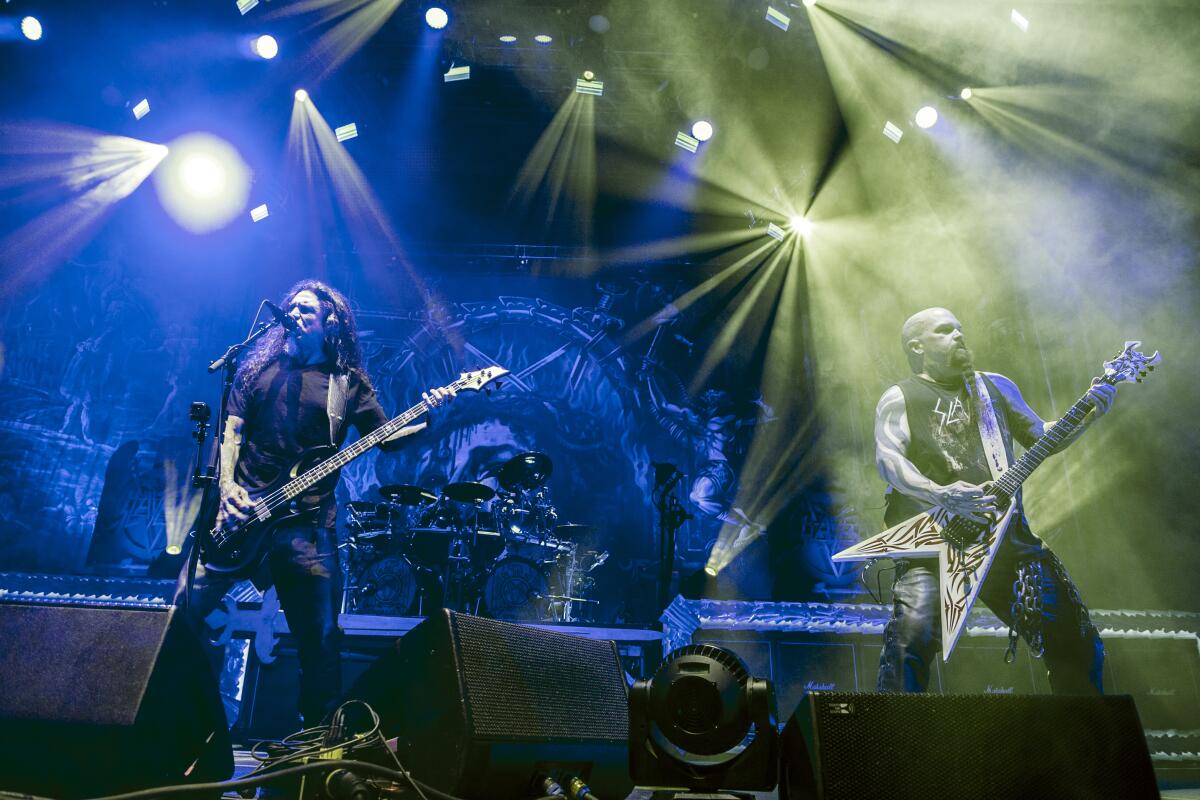
Within a few years, Sales took over as the band’s manager, his first time in that role. While his firm now also manages such popular hard rock acts as Ghost and Mastodon, his decades of work with Slayer remains especially personal.
At his home in the Hollywood Hills, Sales relaxed by his stereo and vinyl collection with his two Australian shepherds, Frank and Ava. The female dog once belonged to the late Slayer guitarist Jeff Hanneman, whose death from alcohol-related liver disease in 2013 left a lasting wound on the band.
“It’s very hard to talk about,” Sales says quietly of Hanneman’s death. “I was in the midst of it.”
That left Araya and King as the band’s two remaining founding members. (Drummer Dave Lombardo left in a financial dispute.) For the last six years, Hanneman’s position on guitar at stage right has been filled by a friend, Gary Holt of Exodus. On drums is Paul Bostaph, a recurring band member who has appeared on seven Slayer albums.
After Hanneman’s death, Slayer rallied to record the well-received “Repentless” in 2015. Out of that record came a trilogy of extremely bloody and elaborate music videos (with guest star Danny Trejo) that was combined with live concert footage to create the movie “The Repentless Killogy,” released in theaters and on Blu-ray this month.
“I thought that this was a real comeback record, and I’m hoping that the culture is coming back into paying attention to guitars,” says Sales, noting that troubles in society often lead to disaffected men and women turning to the bleak message of thrash. “That sort of societal situation breeds aggravated people, and they take it out in their music. I think we’re on the precipice of that all coming back.”
The roots of that sound go back to neighborhoods of Los Angeles County, where a pair of young unknown bands named Slayer and Metallica were experimenting with a new noise called thrash. It was harder and faster than the glam-metal dominating the Sunset Strip.
One up-close witness to Slayer’s earliest period was Brian Slagel, who met the original quartet as he was creating his fledgling Metal Blade Records label out of his mom’s garage in Sherman Oaks. They were all longhaired metal kids, but Hanneman was also a punk-rock fanatic, and he brought the speeded-up energy of the Dead Kennedys and the Misfits to the band’s two-guitar metal foundation.
“They were very serious and had a vision of what they wanted to do, which really was quite a bit different from the other bands,” says Slagel, who released Slayer’s first two albums, 1983’s raw “Show No Mercy” and 1985’s “Hell Awaits.”
“Being in the studio with those guys was eye-opening. I had never been with a band that was that focused, that driven and honestly that talented,” Slagel says. “They were coming up with amazing things.”
Underground metal bands did not mix easily with the more pop-flavored hair-metal acts of the moment epitomized by Poison and Mötley Crüe. Metallica relocated to San Francisco and a scene more welcoming of their heavier sound, but Slayer stuck it out in suburban Huntington Park, 16 miles from the Sunset Strip.
In 2010-11, Metallica paid tribute to that shared history by heading a series of “Big 4” festival concerts alongside fellow thrash originators Slayer, Megadeth and Anthrax. It was Slayer’s first time sharing a stage with Metallica since they both performed at the tiny Woodstock rock club in Anaheim three decades earlier.
Rubin first saw Slayer around that time at the Ritz in New York City. Even though Def Jam was essentially a hip-hop label, Rubin knew he had to sign Slayer.
“In all of my experience seeing live music, punk rock, hard rock, heavy metal, I had never seen or heard anything with the power and energy of Slayer,” Rubin says now. “It was mind-blowing.”
In the ‘80s, there were fan riots at the Hollywood Palladium and the Country Club in Reseda, with shows frequently picketed by Christian protesters with signs and megaphones. Sales remembers seeing a 60-ish record exec in a velour track suit waiting to cross the street getting clubbed by a cop outside a Slayer show.
After “Reign in Blood,” Slayer was established as a foundational pillar of modern metal. Other bands sold more records, but Slayer set a standard.
Aside from a fallow period during the grunge era, when Slayer found itself playing smaller rooms again, the thrash act has maintained a central place in the metal world, both on record and on the road. Now, as the current tour draws to a close, the end of that story is near.
“I’ve seen a bunch of these shows, and you see people getting super-emotional at them,” says Slagel. “It’s a bummer that it’s happening, but everything has its beginning and end.”
Sales says he’ll spend the final night watching the first band he ever managed from the sound desk, surrounded by thousands of metal fans, as always. “It’s bittersweet for sure,” Sales says. “I’ve been here 31 years — a good percentage of my adult life. I want to have the same experience as the audience.”
More to Read
The biggest entertainment stories
Get our big stories about Hollywood, film, television, music, arts, culture and more right in your inbox as soon as they publish.
You may occasionally receive promotional content from the Los Angeles Times.

